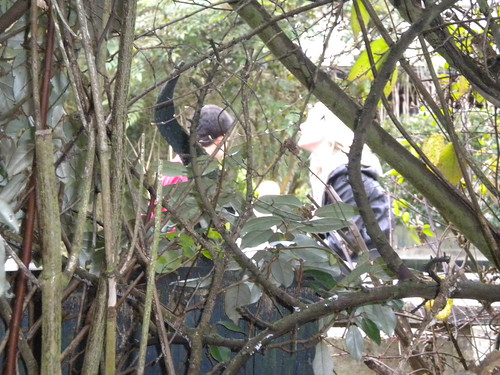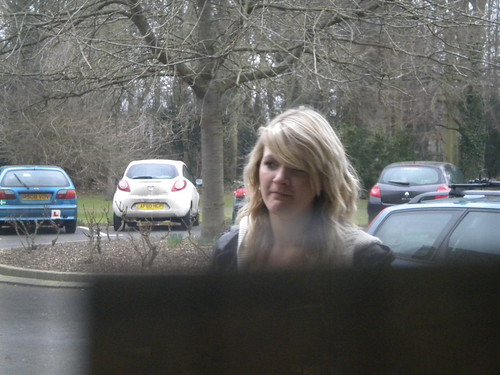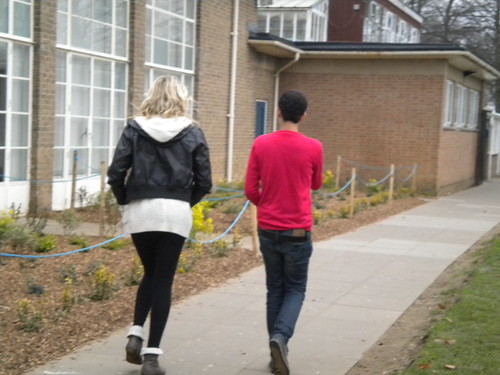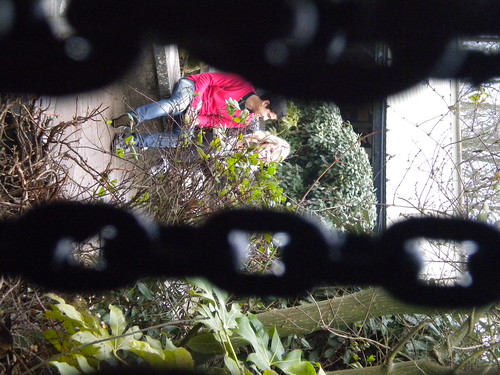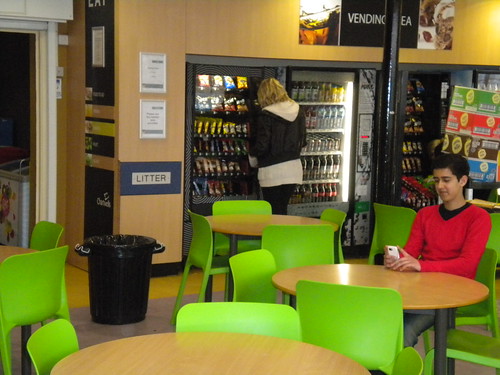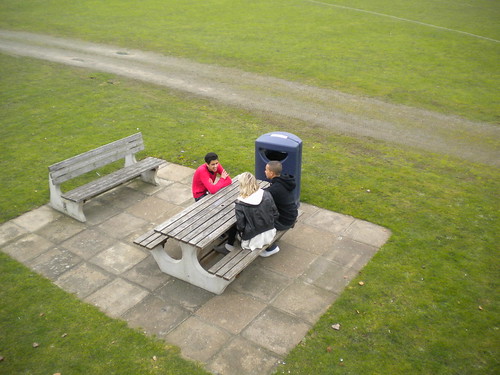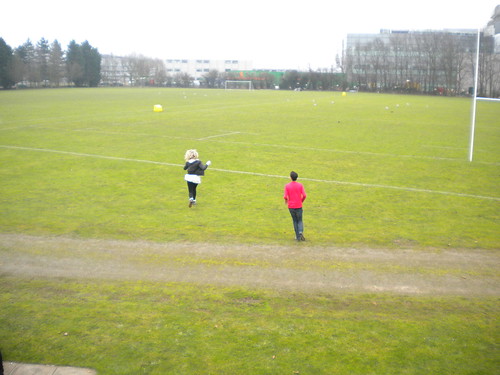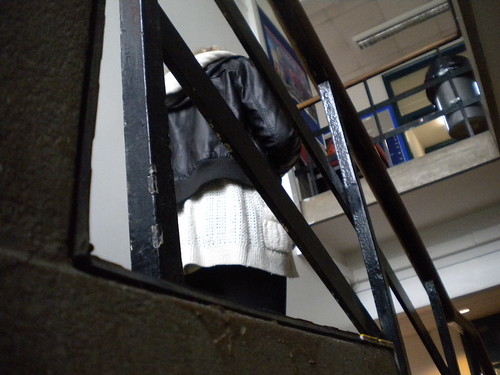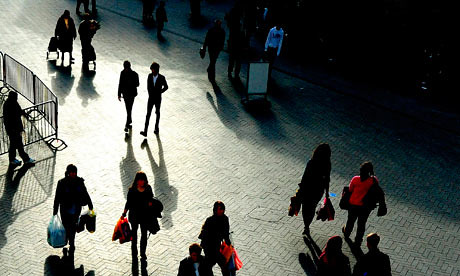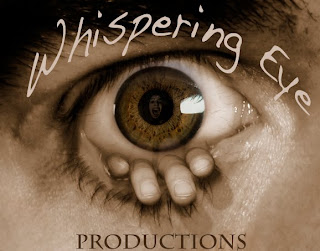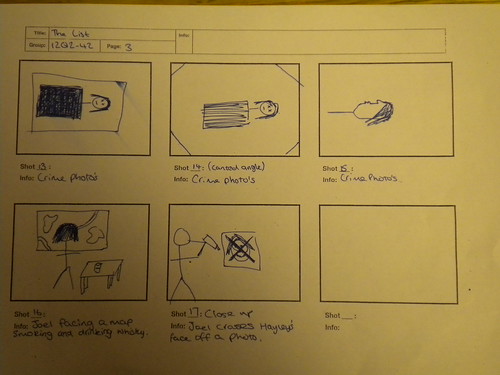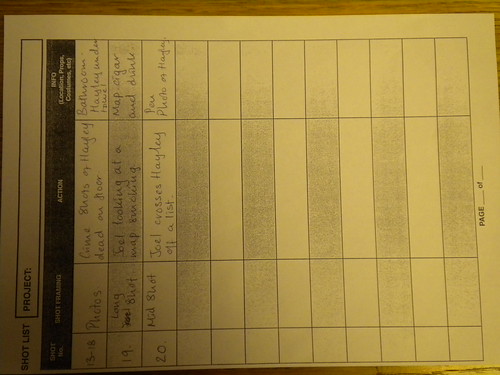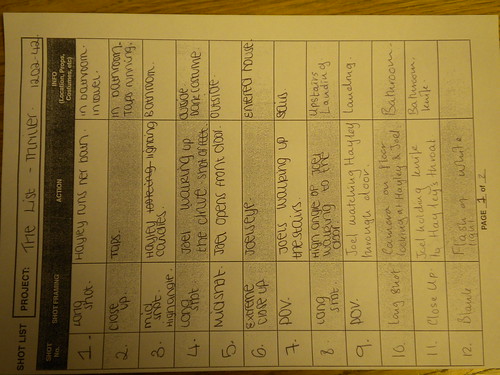- Continuity of the editing could be improved, from shot to shot, the transitions could be smoother creating a more natural effect.
- Hayley's death looked unrealistic and unnatural.
- Variation of sound a bit too much, taking away from the effects natural sound can have.
- Titles over exaggerated especially with the sound of thunder, could be displayed in the actual film.
- Soundtrack cuts in and out, maybe a continuous soundtrack throughout the sequence would be more effective.
Monday, 21 March 2011
Criticisms Of The Final Piece
Labels:
Hayley Moore,
Joel Orme,
Ollie Montique,
Sahib Sohanpal
Thursday, 17 March 2011
Final Piece
Above is our final video.
Labels:
\,
Hayley Moore,
Joel Orme,
Ollie Montique,
Sahib Sohanpal
Art of the Title
Image one: The first image is showing the location in which this opening occurs at. Our film starts with this shot, establishing the surroundings and making the audience aware of where this is happening. We thought having this shot in the dark/at night sets the mood of the movie and fits the genre, thriller.
Image two: The second image is to show props, in the shot we can see Joel's hands reaching for a glass of whiskey. It is to show that he's quite relaxed in this environment which is intended to create a sense of anxiety and worry from the viewers perspective in that he can be so calm, composed and natural after partaking in such an extraordinary event which is murder.
Image three: This image is to show the varying shot types we used, in the screen grab there is a mid-shot of Joel, and you can also see over his shoulder. However in the video the shot starts as a long-shot and ends as a closeup over Joel's shoulder.
Image four: The eye plays a big part in thriller conventions, also linking in with our production logo. The presence of the eye in this scene makes the audience feel as if they are being watched but at the same time making them feel as if they know what is going.
Image five: This image adheres to the conventions of thriller films in that the title of the film appears during the opening sequence. This is key as the film title is indicative of the genre and the content of the film.
Image six: This image shows another camera angle, this time canted. The image on screen in this shot is portrayed to the viewer as a photo taken on a camera in the style of crime scene images. As this is on the side getting the view of her body from a different side, this varies shot types and styles.
Image seven: In this image, we can see one of the different forms of lighting that we used, it is effective in showing what is goiung on without t
Labels:
Hayley Moore,
Ollie Montique,
oo,
Sahib Sohanpal
Thursday, 10 March 2011
Peer Review Feedback
Editing- Good pace, take the edge off production logo. Complete. Dramatic cuts- no rain on the streets, need music over the titles, good long take up the stairs. Longer shot of shadow would have been better if Hayley was moving, photos could look better with a frame and a white flash in between. the zoom onto a photo of Hayley is too quick. The title at the end could be moved to the end of the crime photos, using a camera shutter noise.
Sound (inc. Music)- Good use of diagetic sound i.e. footsteps, Majority of music doesn't correspond (doesn't flow), good link with weather e.g. rain and thunder, TOO MUCH SOUND!!!
Camerawork- Good range of camera shots that kept the audience interested, camera movement was kept at a steady pace, camera angles introduced the characters well, gave the audience an idea of who the protagonist was.Too improve use less shaking when using handheld.
Mise en Scene- The jukebox is really cool, use of costume is good, Protagonist jacket was good and shows that he was well kept, cannot comment on victims clothing.
Titles- striking! good flashing, big and bold, need to keep them there for a longer amount of time.
Thriller conventions- Normally the criminal is unknown and not supposed to be revealed in the opening sequence, women are seen as vulnerable - nice one! Really eye-catching, credits were appropriate, ordinary situation, build up of suspense, viewer placed in position of voyeur, centre's around crime.
Sound (inc. Music)- Good use of diagetic sound i.e. footsteps, Majority of music doesn't correspond (doesn't flow), good link with weather e.g. rain and thunder, TOO MUCH SOUND!!!
Camerawork- Good range of camera shots that kept the audience interested, camera movement was kept at a steady pace, camera angles introduced the characters well, gave the audience an idea of who the protagonist was.Too improve use less shaking when using handheld.
Mise en Scene- The jukebox is really cool, use of costume is good, Protagonist jacket was good and shows that he was well kept, cannot comment on victims clothing.
Titles- striking! good flashing, big and bold, need to keep them there for a longer amount of time.
Thriller conventions- Normally the criminal is unknown and not supposed to be revealed in the opening sequence, women are seen as vulnerable - nice one! Really eye-catching, credits were appropriate, ordinary situation, build up of suspense, viewer placed in position of voyeur, centre's around crime.
Labels:
Hayley Moore,
Ollie Montique,
Sahib Sohanpal
Plan Of Action
- The first stage of moderating our opening sequence is too rearrange the titles in the credits sequence to something m,ore continuous and simplistic.
- varying the different types of sound we have as feedback suggested it was over complicated and over drowned the natural sound which itself creates good effect.
- Next using the criticism made that some of the music didn't match the action we will carefully re select the sounds from garage band and the cd's provided to create more appropriate sounds.
- varying the different types of sound we have as feedback suggested it was over complicated and over drowned the natural sound which itself creates good effect.
- Next using the criticism made that some of the music didn't match the action we will carefully re select the sounds from garage band and the cd's provided to create more appropriate sounds.
Labels:
Hayley Moore,
Ollie Montique,
Sahib Sohanpal
Wednesday, 9 March 2011
Thriller Movie Research
We watched several different thriller openings, such a Momento, Se7en, Taken, Bourne Identity, Donnie Darko, Law Abiding Citizen etc. These all started differently and helped us to create an idea.
We also watched past students work and this helped us to piece together our final clip of the protagonist in his office.
After piecing all of our ideas together and changing a few bits we did not think fitted, we finally completed our piece and moved onto the editing stage.
We also watched past students work and this helped us to piece together our final clip of the protagonist in his office.
After piecing all of our ideas together and changing a few bits we did not think fitted, we finally completed our piece and moved onto the editing stage.
Labels:
Hayley Moore,
Joel Orme,
Ollie Montique,
Sahib Sohanpal
Rough Cut
Learning Points
- We learnt how to make our credits much more interesting and this helped us create more tension and atmosphere in our opening sequence.
- We also learnt various editing techniques that we used to shorten some scenes to make them more effective and pulse-raising.
- The most important thing we learnt was to use the thriller conventions and put them into our sequence.
Criticism
We believe that when other members of the group watch our sequence we think that the main problem they will have is with the music at the beginning and at the end. We felt as though the sound effects used at the end during the opening titles were not effective because they did not totally represent our sub-genre and was used on a loop because there was nothing else that was similar but longer.
Final Deadline
For the final deadline we will definitely be changing the soundtrack at the beginning and at the end, and we will also be changing the opening titles as they were not effective and we used a white background but this is not a major thriller convention.
Labels:
Hayley Moore,
Joel Orme,
Ollie Montique,
Sahib Sohanpal
Colours
There are three main colours that are related to the thriller genre. These tend to be the main focus and are Red, Black and White.
RED is used as a contrasting colour in thrillers compared to many other movies when this colour can relate to love and happiness however in movies with a genre such as ours, this relates to hatred, blood, death and danger.
BLACK is a common colour in many movies however it is emphasised greatly in thrillers. The audience will automatically anticipate something dark, mysterious and negative when this colour is used.
WHITE is another colour with several relations. Being a simple colour, this can be used in many different ways and for different reasons. It also contrasts with black, being the complete opposite, so when this colour is shown this may create a feeling of security within the audience as opposed to black.
RED is used as a contrasting colour in thrillers compared to many other movies when this colour can relate to love and happiness however in movies with a genre such as ours, this relates to hatred, blood, death and danger.
BLACK is a common colour in many movies however it is emphasised greatly in thrillers. The audience will automatically anticipate something dark, mysterious and negative when this colour is used.
WHITE is another colour with several relations. Being a simple colour, this can be used in many different ways and for different reasons. It also contrasts with black, being the complete opposite, so when this colour is shown this may create a feeling of security within the audience as opposed to black.
Labels:
Hayley Moore,
Joel Orme,
Ollie Montique,
Sahib Sohanpal
Sound Review
After devising our initial soundtrack and importing it onto final cut express we realised not only that the timings of the sound with the action did not fit properly but that different effects could be added to enhance our opening sequence. This included adding a variety of non-diagetic sounds to the opening credits for specific affect. Finding these sounds proved difficult but using both garage band and a combination of cd's containing various sounds provided for us we have established the sounds we want in our entire sequence. Now we have the challenge of matching the sound with the action to create an effective soundtrack for our sequence.
Labels:
Hayley Moore,
Joel Orme,
Ollie Montique,
Sahib Sohanpal
Monday, 7 March 2011
New Logo
After much thought we decided that we should change our production logo quite sufficiently, the changes involved changing the text that we used and the colours. Also the changes that were made were relevant to the future animation of our logo.
Previous production logo:
Current production logo:

Previous production logo:
Current production logo:

Feedback on draft opening sequence
in order to create the best opening sequence possible we had teachers and peers watch our draft and feedback on possible improvements that could be made or elements that could be changed, the crucial withdrawals from this task included:
- the establishing shot of the house was not long enough, and therefore did not fully portray the mysterious image and immediate setting we intended.
- An increased use of non-diagetic sounds would create a more suspenseful atmosphere like we desired.
These criticisms provide us with the information we wanted o further improve our thriller opening sequence and we will be using them as influence whilst we edit and moderate our sequence.
- the establishing shot of the house was not long enough, and therefore did not fully portray the mysterious image and immediate setting we intended.
- An increased use of non-diagetic sounds would create a more suspenseful atmosphere like we desired.
These criticisms provide us with the information we wanted o further improve our thriller opening sequence and we will be using them as influence whilst we edit and moderate our sequence.
Sunday, 6 March 2011
Seven Opening Credits
The opening credits of the film Seven are ones which we can draw creative ideas from as well as admire for number of reasons. Whilst relatively simple working with a simple font and basic white colour, the titles appear flickering onto the screen in time with certain non diagetic pieces of music. The manner in which the titles enter the screen for example the variety of paces, angles and transitions used set the tone for the film and to a certain extent are an indication to the viewer that the film will entale a variety of twists in a mysterious manner similar to that of the credits. the idea of setting the tone and pace of your film in the credits is one that we intend to replicate whilst devising our titles for the opening sequence.
http://www.youtube.com/watch?v=SEZK7mJoPLY
http://www.youtube.com/watch?v=SEZK7mJoPLY
Thursday, 3 March 2011
Music and Sound
At the beginning of the sequence we have our music alongside the production logo, this meets thriller conventions creating a mysterious atmosphere for the upcoming film. This also sets the genre.
Our music starts off calm but eerie, with a string instrument playing. This then starts to create tension when footsteps are heard over this until the music has died out and footsteps have taken over. The stairs then creak creating more tension and the running bath water also contrasts. Once the protagonist approaches the antagonist a heart beat is heard during the scene where the antagonist is killed. As they are being killed and it goes through slow motion there is a clicking sound, also slowed down, as the scene flicks from light to dark. This helps to add to the tension being created by the slow motion and lighting.
At the end of the opening sequence, when the protagonist has completed his killing, he is then filmed in his office and plays music from the jukebox in this room (Sultans of Swing - Dire Straits). The way this has been filmed was to make sure it was made aware to the audience this was diegetic sound because the protagonist is listening.
Another key part of our soundtrack is the production sound, the natural sound that comes with the environment and movements of our characters, this is key as it suggests and entirely normal and usual situation. Then combining this with the unusual action that happens in the normal scenario is key to the opening sequence and the emotive response we intend from our viewers of suspense and tension.
Our music starts off calm but eerie, with a string instrument playing. This then starts to create tension when footsteps are heard over this until the music has died out and footsteps have taken over. The stairs then creak creating more tension and the running bath water also contrasts. Once the protagonist approaches the antagonist a heart beat is heard during the scene where the antagonist is killed. As they are being killed and it goes through slow motion there is a clicking sound, also slowed down, as the scene flicks from light to dark. This helps to add to the tension being created by the slow motion and lighting.
At the end of the opening sequence, when the protagonist has completed his killing, he is then filmed in his office and plays music from the jukebox in this room (Sultans of Swing - Dire Straits). The way this has been filmed was to make sure it was made aware to the audience this was diegetic sound because the protagonist is listening.
Another key part of our soundtrack is the production sound, the natural sound that comes with the environment and movements of our characters, this is key as it suggests and entirely normal and usual situation. Then combining this with the unusual action that happens in the normal scenario is key to the opening sequence and the emotive response we intend from our viewers of suspense and tension.
Labels:
Hayley Moore,
Joel Orme,
Ollie Montique,
Sahib Sohanpal
Editing
After capturing our footage it was important that we moved straight on to the editing process in order to create the impressions and feelings that we wanted from our footage. For example, piecing certain shots and bits of footage together to create a fast past and suspenseful opening was a crucial aim of ours.
Firstly, we moved all of our footage from the camera onto final cut express, after this we chose fro,m the various pieces of footage we had which was over 70 separate pieces and cut it down to 23. In this process it was key that we chose the best and most applicable clips. for example we had various clips of Hayley turning on the tap early in the sequence and had to narrow it down to the one we felt created the most suspenseful atmosphere based on the lighting and character movements in each clip.
We added effects and transitions between clips to create the smooth flow of the piece and make sure there were no major jumps or mishaps. Once we had watched this through after inserting these we noticed parts were footage still jumped or overlapped, we then changed this and added the necessary transitions.
Firstly, we moved all of our footage from the camera onto final cut express, after this we chose fro,m the various pieces of footage we had which was over 70 separate pieces and cut it down to 23. In this process it was key that we chose the best and most applicable clips. for example we had various clips of Hayley turning on the tap early in the sequence and had to narrow it down to the one we felt created the most suspenseful atmosphere based on the lighting and character movements in each clip.
We added effects and transitions between clips to create the smooth flow of the piece and make sure there were no major jumps or mishaps. Once we had watched this through after inserting these we noticed parts were footage still jumped or overlapped, we then changed this and added the necessary transitions.
Labels:
Hayley Moore,
Joel Orme,
Ollie Montique,
Sahib Sohanpal
Monday, 28 February 2011
Credits Practice
This was some practice that I did to get used to making credits interesting and move about a little bit. I also added some music to see whether I could find anything on GarageBand that would sound appropriate to the sequence that we are doing. I am now confident in my ability to make the credits more interesting than they were in my children's film project.
Thursday, 10 February 2011
Surveillance Photos
Labels:
Hayley Moore,
Joel Orme,
Ollie Montique,
Sahib Sohanpal
Production Logo
We have decided to use this as our production logo because we think it is quite creepy and sums up our thriller. Also the eye is a key convention used in thriller films so it is relevant to use in our logo.
Labels:
Hayley Moore,
Joel Orme,
Ollie Montique,
Sahib Sohanpal
Wednesday, 9 February 2011
Storyboard
Labels:
Hayley Moore,
Joel Orme,
Ollie Montique,
Sahib Sohanpal
Wednesday, 2 February 2011
Improvements for our thriller:
Improvements that can be made:
- Make sure sound has a lot of time spent on it and ensure it is uploaded with the video.
- Include the title and make the credits more interesting.
Positives:
- Bright colours - attracted the audience.
- Music was happy and fitted in with the genre.
Peer Evaluation Of Children's Film
Hayley, Ollie and Musty.
Positive feedback:
- Colourful- key convention of children's film.
- Funny - also a convention, amuses children.
- Some good drawings- easy for children to differentiate between characters.
- Framing was poor, sometimes the camera/ setting was tilted to the side and table and wall were visible beyond setting.
- No idea what was happening as there was no dialogue.
- Film had no title and credits were poor.
Labels:
Chloe Housden,
Heidi Izatt,
Joel Orme,
Sahib Sohanpal
Filming Dates
Thursday 10th February: After college at Hayley's.
If needed - Thursday 17th February: After the half day at Hayley's.
If needed - Thursday 17th February: After the half day at Hayley's.
Labels:
Hayley Moore,
Joel Orme,
Sahib Sohanpal
Monday, 31 January 2011
Pitch Evaluation
Do you find out the name of the killer?
No, the killers name is not revealed throughout as his identity is not shown, nor is his face.
What made you come up with the idea?
Our idea was based around the props we wanted to use. We decided this first and then escalated from there.
How long should you need to film?
We are planning to spend an evening on this and this should be complete. If not then we will take the camera out for another evening.
Where are you planning to film?
We are planning to film at Hayley's house.
What font are you planning to use for the credits and how will they enter the screen?
We will use a simple font and they will enter the screen subtly in order to cause no distraction from what is happening in the scene.
No, the killers name is not revealed throughout as his identity is not shown, nor is his face.
What made you come up with the idea?
Our idea was based around the props we wanted to use. We decided this first and then escalated from there.
How long should you need to film?
We are planning to spend an evening on this and this should be complete. If not then we will take the camera out for another evening.
Where are you planning to film?
We are planning to film at Hayley's house.
What font are you planning to use for the credits and how will they enter the screen?
We will use a simple font and they will enter the screen subtly in order to cause no distraction from what is happening in the scene.
Labels:
Hayley Moore,
Ollie Montique,
Sahib Sohanpal
Thursday, 27 January 2011
Pitch Post
Setting - Ollie
Big map of a certain area on a wall, photos of people in selected areas who we will kill. Markings written with either glow stick liquid or magic ink to create different lighting effects and make it seem more mysterious.
Plot - Sahib
Hayley walks into her bathroom and turns the bath taps on. Camera switches to Joel entering the house from his p.o.v and walking up the stairs. once he gets to the top there will be a high angled shot from the loft showing Joel walking towards the bathroom. camera switches back to Joel looking through the door followed by Hayley lighting candles, turning of the light and stepping into the bath. Joel comes in and puts a knife to Hayley's throat and whispers in her ear. she then falls to the floor as he strangles her and then he covers her with her towel. Joel goes back to his room and then ticks off Hayley's picture from his list.
Sub Genre - Hayley
Psychological thriller.
Title - The List.
Characters -
Killer - Joel
Victim - Hayley
Locations - Ollie
Bathroom where the action happens.
Office where the killer keeps his information.
Lighting - Ollie
Normal lighting in the bathroom until candles are turned on then the main light is turned off and the room is only lit by candles. When Joel comes up the stairs the lighting is dark and you can only see the back of him. Once he enters the room the lighting is dimmed. In the office the markings written with either glow stick liquid or magic ink to create different lighting effects and make it seem more mysterious.
Costumes - Sahib
Killer (Joel)- all black until in office wearing a old-fashioned suit jacket.
Hayley - Towel with something under.
Music and Sound - Sahib
Non-diagetic sound as Hayley prepares her bath ;) music playing in the bath room and when Joel walks up the stairs the volume level is increased. When Joel enters the bathroom, there is a change in music and then a heartbeat when the knife is put to Hayley's throat. When Joel is in his office there is contrapuntal music playing.
Big map of a certain area on a wall, photos of people in selected areas who we will kill. Markings written with either glow stick liquid or magic ink to create different lighting effects and make it seem more mysterious.
Plot - Sahib
Hayley walks into her bathroom and turns the bath taps on. Camera switches to Joel entering the house from his p.o.v and walking up the stairs. once he gets to the top there will be a high angled shot from the loft showing Joel walking towards the bathroom. camera switches back to Joel looking through the door followed by Hayley lighting candles, turning of the light and stepping into the bath. Joel comes in and puts a knife to Hayley's throat and whispers in her ear. she then falls to the floor as he strangles her and then he covers her with her towel. Joel goes back to his room and then ticks off Hayley's picture from his list.
Sub Genre - Hayley
Psychological thriller.
Title - The List.
Characters -
Killer - Joel
Victim - Hayley
Locations - Ollie
Bathroom where the action happens.
Office where the killer keeps his information.
Lighting - Ollie
Normal lighting in the bathroom until candles are turned on then the main light is turned off and the room is only lit by candles. When Joel comes up the stairs the lighting is dark and you can only see the back of him. Once he enters the room the lighting is dimmed. In the office the markings written with either glow stick liquid or magic ink to create different lighting effects and make it seem more mysterious.
Costumes - Sahib
Killer (Joel)- all black until in office wearing a old-fashioned suit jacket.
Hayley - Towel with something under.
Music and Sound - Sahib
Non-diagetic sound as Hayley prepares her bath ;) music playing in the bath room and when Joel walks up the stairs the volume level is increased. When Joel enters the bathroom, there is a change in music and then a heartbeat when the knife is put to Hayley's throat. When Joel is in his office there is contrapuntal music playing.
Labels:
Hayley Moore,
Joel Orme,
Ollie Montique,
Sahib Sohanpal
Wednesday, 26 January 2011
Thriller Ideas
1. Action Thriller:
Some one drowning in a bathtub, fill it up and have them laying there with a wet hand print on the door, someone being strangled - strobe
2. Psychological Thriller:
Big map of a certain area on a wall, photos of people in selected areas who we will kill. Markings written with either glow stick liquid or magic ink to create different lighting effects and make it seem more mysterious.
Hayley walks into her bathroom and turns the bath taps on. Camera switches to Joel entering the house from his p.o.v and walking up the stairs. once he gets to the top there will be a high angled shot from the loft showing Joel walking towards the bathroom. camera switches back to Joel looking through the door followed by Hayley lighting candles, turning of the light and stepping into the bath. Joel's comes in and puts a knife to Hayley's throat and whispers in her ear. she then falls to the floor as he strangles her and then he covers her with her towel. Joel goes back to his room and then ticks off Hayley's picture from his list.
Some one drowning in a bathtub, fill it up and have them laying there with a wet hand print on the door, someone being strangled - strobe
2. Psychological Thriller:
Big map of a certain area on a wall, photos of people in selected areas who we will kill. Markings written with either glow stick liquid or magic ink to create different lighting effects and make it seem more mysterious.
Hayley walks into her bathroom and turns the bath taps on. Camera switches to Joel entering the house from his p.o.v and walking up the stairs. once he gets to the top there will be a high angled shot from the loft showing Joel walking towards the bathroom. camera switches back to Joel looking through the door followed by Hayley lighting candles, turning of the light and stepping into the bath. Joel's comes in and puts a knife to Hayley's throat and whispers in her ear. she then falls to the floor as he strangles her and then he covers her with her towel. Joel goes back to his room and then ticks off Hayley's picture from his list.
Labels:
Hayley Moore,
Joel Orme,
Sahib Sohanpal
Monday, 24 January 2011
Universal Ident
The universal production indent is reflective of their company based on the imagery and other aspects used to create an idealistic portrayal of the company. Firstly, the earth is suggestive that company covers a vast range of spectrums in terms of their productions, varying genre of film, this is crucially linked with the name universal outlined in bold which is again suggesting the company has no fixed genre or film type to create and can vary hugely across all ranges. The bold colours such as dark blues are portraying a largely powerful company, implying an element of this in the films they create. The music for the ident is again powerful, with uplifting bld sounds across a short periood of time. This is crucial to universal as a brand in terms of marketting as the sound to the ident is very much memorable and iconic. As the words universal pan across the Earth, covering it in its entirety it is indicative of the companies vast and monumental standing, this is important in terms of the film as conventionally after seeing a Universal ident you are expecting to see a film of high quality. Overall the general implications made and reflections of the company based on the ident using sound, lighting and content is that the company in itself is a powerful and diverse company varying in term so f film genres, this is shown through the Earth and its connotations. As well as adding to this implication the ident soundtrack is memorable and uplighting promoting a positive image of the company designed to be remembered form the audience's perspective in the future.
Another ident which has been edited to suit the theme of the film is shown below:
Labels:
Hayley Moore,
Ollie Montique,
Sahib Sohanpal
Thursday, 20 January 2011
Sound Analysis (The Descent - Theatrical trailer)
Without Sound
The trailer of this film without sound didn't horrify me or make my pulse raise. This is because the start of it shows the girls happy and talkative, this shows me nothing about what they are about to go through. The images in the clip originally made me feel happy but after the initial happy part, the words came up on the screen and there was much more black screen. The words, although they looked quite good, did not have the effect on me that was planned, this was down to the lack of noise as they appeared. This confused me as I did not know where the film was or what was happening. At the end when the girls are underground, my pulse raised a little but I wasn't sure whether they were supposed to be there or not. The images showed they were distressed and this made me slightly distressed as well. I was not able to relate to the characters without sound because I did not know for sure what they were saying, this made me unable to relate to what they were saying, for instance they could have planning on going underground and finding all these disturbing things, I could not relate to his, or they could have been planning on staying overground and having a good time with friends company, and I could relate to this. I felt it was hard to relate to the characters as I couldn't tell what each of them was like, by the way characters in films talk you get an insight into their personality, not being able to hear them means I couldn't have this insight and so I couldn't relate personality wise to the characters in this trailer.
With Sound
The non-diagetic soundtrack that runs through the trailer really helped me understand what genre the film was and made me more worried than what I was before I heard the sound. The soundtrack starts of non-empathetical where the characters are having a good time and laughing but the soundtrack is quite sinister, this gives the impression that something bad is going to happen but the girls and the audience do not know what that is yet. When the images become sinister and the characters get stuck underground the non-diagetic soundtrack increases in volume and then stops whilst the audience can hear the diagetic sound effect of the cave and tunnel crashing down on them, the soundtrack then starts again but louder and with a shock start. This carries on until the end when the soundtrack becomes a little quieter, this is done so the audience want to see more. During the images, words come up on a black screen. For example, "fear" and "claustrophobic", these are joined with sound effects to make the words seem scarier, with the word "fear", they have made it jump around on the screen, sound is used as well at this point by making the sound jump about as well. The soundtrack is constantly increasing in volume and pitch ever so slightly, this builds tension in the viewer. My reaction to this clip is now very different. I am now wanting to see this film but I am also quite scared by it, the soundtrack and effects have made me worried about what happens at the end of the film and they have also backed up my suspicions that it is a thriller with many scary moments. The sound has encouraged me feel panic and tension as I hope that the girls get out alive, it has also made me react uncomfortably as I can hear their distress but do nothing to stop it or help them. The sound has also made my pulse react and has raised it because of the tension that was being built with the slowly increasing volume and pitch but also by the sinister music that jumps about temprementally and with obvious direction.
Conclusions
I have concluded that sound is very important in the making of a film, especially one that intends to frighten and scare people. I have concluded that by increasing the tempo, pitch and volume of the sound slowly throughout the clip can make the audience react from the outset and scare them more in a shorter space of time as they can tell what is going to happen to the characters even when they are happy and talkative. I hope to ahieve the same effect that this clip had on me in my opening sequence of a thriller film, I shall incorporate sinister music and very little effects, I shall also have some silence as this scared me in the trailer because of the feeling of the unknown. In colnclusion, I shall have both sound and silence as I feel I was scared when I saw the clip without sound because of the feeling of entering the unknown but I was also scared when I heard the sound because it created tension and so I could anticipate something going wrong but I couldnt pinpoint what it was.
Labels:
Hayley Moore,
Joel Orme,
Ollie Montique,
Sahib Sohanpal
Wednesday, 19 January 2011
Analysing Protagonist and Antagonist in 'The Bourne Identity'

The protagonist and antagonist is made very clear to the audience from the start of the scene. The protagonist, Matt Damon, has most of the screen time on his face even when both characters are in shot and he does all the talking with the antagonist just sneering and making threatening comments, this puts the antagonist in a bad light. The protagonist hits the antagonist and he starts bleeding quite badly, however when the antagonist hits the protagonist no blood or wounds are shown to make the protagonist look unbeatable. The protagonist also does all the killing in the sequence and has the best weapons and most stylish costume out of all the other characters, for instance at one point he has a modern handgun whereas the bad guy has an old revolver. The protagonist was always framed higher than the antagonist to show dominance and you see the protagonist looking down over the bannister.
Labels:
Hayley Moore,
Joel Orme,
Ollie Montique
S1-21 Thriller Opening Sequence Evaluation
Loose Control:
The opening sequence from the group is very impressive. containing a number of the conventional aspects of a psychological thriller and cleverly manipulating the micro elements to provoke certain emotions towards different characters form the audience. Combining varying shot types with a mysterious soundtrack the opening sequence is successful in matching the conventional aspects of thrillers, particularly psychological thrillers. The use of a distorted radio signal sound immediately creates a sense of disorientation with the main character and therefore the audience. The opening incorporates various shot types, however the particular use of close ups and extreme close ups is crucial to portraying the emotions of the main character which is primarily fear, thus evoking sympathy from the audience. Also this is important in suggesting the Antagonist and Protagonist. Within the opening is a clever use of different shot types and angles to create a sense of disorientation and create the impression that the main woman is being followed or stalked by the man. The man following the woman is shown in reflection often and in a number of different positions looking directly at the woman, this not only portrays a sense of great fear from her perspective which is suggested to the audience again evoking empathy. Another conventional aspect of psychological thrillers it meets is using the eye as a clear indication of a characters emotion and surroundings, in this case fear and a sense of vulnerability, also portrayed by the high angle shots on the woman from the mans perspective. The movement of the soundtrack from first a slow p[aced mysterious one to a more upbeat and fats paced one is reflective not only of the chase and action taking place, but is suggestive that the man is almost enjoying his pursuit of the woman. Towards the end of the opening, the manner in which the woman is cornered by the man again adds to the sense of vulnerability and fear from the perspective of the woman. Through combining all of these aspects, the opening provides a clear and immediate indication as to who is the antagonist and protagonist.
Labels:
Hayley Moore,
Joel Orme,
Ollie Montique
Past Student Work - T2:58 - On The Rocks
T2-58 THRILLER - FINAL from SATMEDIA on Vimeo.
On the rocks:
They held the shots steadily however mainly consisted of mid shots with the odd close up and long shot. They could have varied this more. We thought the mise-en-scene was good and the use of props also. He was smoking at the beginning of the scene, and then also at the end you see the cigarette smoke around the light which shows they are linking back to this prop and this could have further relevance. Also when there is a pan of the room a bottle of alcohol is shown, later on the detective is then drinking this before he moves onto the maps. The detective is drinking whiskey, this is normally drunk 'on the rocks' which links into the title. The costume is quite plain however fits the scene as there is no real need for something extravagant.
Once we had finished watching, we were still unaware of the actual meaning to the film however the material made was appropriate to the task. There were a few different transitions and a vast amount of effects used. Throughout the whole opening sequence there was a constant non-diagetic sound alongside the images and they also used sound affects when the guy was being strangled which was over-exaggerated. The titles were quite interesting and time was taken into making this however the bus coming in at the beginning was not appropriate to the task, or to the film itself.
The antagonist and protagonist were both made clear however we did not feel any emotion towards the protagonist whilst being strangled. We think that more close ups are needed for key elements, for example the cigarette and the photograph of the next victim.
Labels:
Hayley Moore,
Joel Orme,
Ollie Montique
Marking Criteria
Video - 60 marks.
Level one - up to 23 marks.
Level two - 24 - 35 marks. Basic ability.
Level three - 36 - 47 marks. Proficient ability.
Level four - 48 - 60 marks. Excellence ability.
Level one - up to 23 marks.
Level two - 24 - 35 marks. Basic ability.
Level three - 36 - 47 marks. Proficient ability.
Level four - 48 - 60 marks. Excellence ability.
- Using a steady shot where appropriate.
- Framing a shot including and excluding elements.
- Using a variety of shot distances.
- Shooting material appropriate to the task.
- No swearing.
- No young children.
- Selecting the mise-en-scene.
- Editing so that the meaning is apparent to the viewer.
- Using various shot transitions and effects.
- Using sound with images.
- Clear dialogue.
- Using titles appropriately - film credits, title - make it interesting.
Labels:
Hayley Moore,
Joel Orme,
Ollie Montique
Monday, 17 January 2011
Conventions of Crime Thriller
- Immediate introduction to a crime of some sort.
- Central crime grows and escalates.
- Isolated and solitary protagonist.
- Protagonist is seemingly ordinary in terms of his surroundings and appearance.
- Relies on his intelligence rather than violence.
- Lifestyle is reflected in the location.
- Woman again portrayed as vulnerable
- Protagonist often clashes with another character which is central to the plot.
- Lots of silent scenes to exaggerate isolation.
- Gender stereotypes, always washing and cooking and vulnerable.
- Dark lighting used to create atmosphere.
- The setting is quite realistic.
- The pace is quite fast in crime thrillers.
- Central crime grows and escalates.
- Isolated and solitary protagonist.
- Protagonist is seemingly ordinary in terms of his surroundings and appearance.
- Relies on his intelligence rather than violence.
- Lifestyle is reflected in the location.
- Woman again portrayed as vulnerable
- Protagonist often clashes with another character which is central to the plot.
- Lots of silent scenes to exaggerate isolation.
- Gender stereotypes, always washing and cooking and vulnerable.
- Dark lighting used to create atmosphere.
- The setting is quite realistic.
- The pace is quite fast in crime thrillers.
Labels:
Joel Orme,
Ollie Montique,
Sahib Sohanpal
Action movie conventions
The lead characters always have a 'buff' appearance and look appealing to the audience. Normally the protagonist is very good looking because it appeals more for the bag guy to look good. There is a lot of fast paced location change to show there is a lot going on in a number of different places, this also shows the difference in lifestyles. The plot is made obvious from the beginning so we know what is going to happen, this also leaves some of it to our own interpretation and involves us in the movie the whole way. There is no full face shots
Leon: Action Thriller
Conventions of an Action Thriller:
- Crime is often involved.
- Antagonist & Protagonist
- More exposure to actual violence or crime as opposed to psychological thrillers.
- Editing style is continuous and naturalistic.
- Often portrays women or children as vulnerable and protagonist seems to help them.
- Protagonist is a solitary figure.
- Protagonists lives a routine life.
- Audience introduced to the plot immediately, you know what will happen its more how it will happen.
Characters:
There are several characters introduced in the opening sequence. Almost instantly, the main character is introduced and depicted as a hired killer. We learn that he is dangerous after witnessing him commit several violent murders. It is therefore hard to envisage him as the protagonist role, however later on in the sequence it becomes clear that he is in fact the protagonist. This is shown when he sees 'Matilda' the abused little girl has a bruise on her head, and he seems concerned when he questions as to how she acquired it. Matilda is shown as submissive and vulnerable, this could be related to her gender and her age. We are taken on a visual voyage of discovery into her apartment, where we witness abuse from her father and her older sister. The mother of the two daughters and the wife of the father does not talk to the younger daughter, even when the mother and father are in a "intimate" situation, the father is left to deal with the younger daughter. Also, she ignores Matilda's statement that the older sister took her turn to watch the television. Matilda is definitely seen to be an inferior character within her family, this is due to her age and gender, which are key.
conventions in the sub-genre of action thriller. Matilda's father is shown to be a very dominant member of the family but outside of the family he is shown to be very weak. This emphasises the vulnerability of Matilda as the father needs to express his dominance in the family as he has none outside of it.
In contrast to a psychological Thriller, the action thriller uses continuous and naturalistic editing whereas a psychological Thriller will attempt to cause a mysterious effect using montage editing. In terms of whether this is conventional of Thrillers, that is entirely depemndant on the sub- genre of the thriller. One of the most significant shots in the early sequences is the low angle shot of the main character, this emphasis his dangerousness and the fear he commands. Contrastingly to this, we see a p.o.v high angle shot of the protagonist on to Matilda, suggesting again her vulnerability.
- Crime is often involved.
- Antagonist & Protagonist
- More exposure to actual violence or crime as opposed to psychological thrillers.
- Editing style is continuous and naturalistic.
- Often portrays women or children as vulnerable and protagonist seems to help them.
- Protagonist is a solitary figure.
- Protagonists lives a routine life.
- Audience introduced to the plot immediately, you know what will happen its more how it will happen.
Characters:
There are several characters introduced in the opening sequence. Almost instantly, the main character is introduced and depicted as a hired killer. We learn that he is dangerous after witnessing him commit several violent murders. It is therefore hard to envisage him as the protagonist role, however later on in the sequence it becomes clear that he is in fact the protagonist. This is shown when he sees 'Matilda' the abused little girl has a bruise on her head, and he seems concerned when he questions as to how she acquired it. Matilda is shown as submissive and vulnerable, this could be related to her gender and her age. We are taken on a visual voyage of discovery into her apartment, where we witness abuse from her father and her older sister. The mother of the two daughters and the wife of the father does not talk to the younger daughter, even when the mother and father are in a "intimate" situation, the father is left to deal with the younger daughter. Also, she ignores Matilda's statement that the older sister took her turn to watch the television. Matilda is definitely seen to be an inferior character within her family, this is due to her age and gender, which are key.
conventions in the sub-genre of action thriller. Matilda's father is shown to be a very dominant member of the family but outside of the family he is shown to be very weak. This emphasises the vulnerability of Matilda as the father needs to express his dominance in the family as he has none outside of it.
In contrast to a psychological Thriller, the action thriller uses continuous and naturalistic editing whereas a psychological Thriller will attempt to cause a mysterious effect using montage editing. In terms of whether this is conventional of Thrillers, that is entirely depemndant on the sub- genre of the thriller. One of the most significant shots in the early sequences is the low angle shot of the main character, this emphasis his dangerousness and the fear he commands. Contrastingly to this, we see a p.o.v high angle shot of the protagonist on to Matilda, suggesting again her vulnerability.
Labels:
Joel Orme,
Ollie Montique,
Sahib Sohanpal
Fargo Conventions
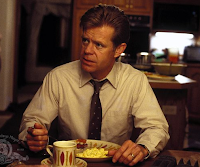 Fargo is a crime thriller. There is use of stereotype in the pub scene, carried through to others when a man is chain smoking throughout most of the footage we saw. The lead male character is slightly confused and clueless, this is quite typical of a film with this genre as there is always someone who does not know what they are doing. The woman is the target in this movie as she is going to be kidnapped, this also portrays a typical image as women are seen as more vulnerable. The way the woman is portrayed is typical for most movies as all shots of her are in the kitchen or when she is cooking for the males or cleaning.
Fargo is a crime thriller. There is use of stereotype in the pub scene, carried through to others when a man is chain smoking throughout most of the footage we saw. The lead male character is slightly confused and clueless, this is quite typical of a film with this genre as there is always someone who does not know what they are doing. The woman is the target in this movie as she is going to be kidnapped, this also portrays a typical image as women are seen as more vulnerable. The way the woman is portrayed is typical for most movies as all shots of her are in the kitchen or when she is cooking for the males or cleaning.More conventions include the surrounding areas for example they portray a sense of isolation for certain characters giving off a signal that something important is going to happen later on. Furthermore, the location is seen to be safe and there is nothing suggestive that this neighborhood is dangerous, also they live in a normal family home which seems happy and safe.
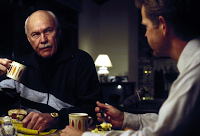 A father-in-law always seems to be against his daughters husband, this is shown in this movie around the dinner table when the husband has a business proposition he discusses with his wives father. The reply is blunt and patronising, this also shows lack of interest in what the husband has to say.
A father-in-law always seems to be against his daughters husband, this is shown in this movie around the dinner table when the husband has a business proposition he discusses with his wives father. The reply is blunt and patronising, this also shows lack of interest in what the husband has to say.
Thursday, 13 January 2011
Analysis of the psychological thriller, Memento:
Memento:
- Voice over - the voice over suggests a stream of consciousness showing a lack of certainty and confusion within the character.
- No memory - he does not know how long he has been in the hotel room, this also suggests that he nay not know who he is.
- Protagonist - achilles heel - he is unable to make any new memories suggesting he is vulnerable and may feel isolated. His way round this is to use his body as a memory or notepad. He has several tattoos of vital information on his body as he is unable to remember these things, this is a good example of mise en scene. He also has photographic evidence of other occurrences.
- Perception of reality - he does not have any idea of what is going on.
- Slow edit - the slow pace and close up images indicate the confusion and drowsiness of the character. The high angle in the hotel room shows us that he is only wearing a shirt and has bare legs.
- Black and white beginning - this suggests to us that when the scene is in black and white, the character is at peace, it also suggests the scene is aged. When the scene is in color the character is more agitated and uneasy.
- Reverse of time - the reverse in time suggests these are memories, this is shown at the beginning when the first scene is turned around and is reversing what happened when the man was shot. This also distorts the sense of continuity in the scene. This is an example of a non-linear narrative because the end is at the beginning of the movie and then the beginning is following this.
- Character - the character portrays a sense of danger and unreliability in the audience as we are watching because he makes us intrigued to find out what will happen next because it could be from one extreme to the other.
- Dual identity - the man has a dual identity, also known as schizophrenic, this adds to the uncertainty the audience have in this character.
- Close up - in the hotel scene there is a close up of the characters eyes, this links in with the beginning when there is a zoom on the broken glasses, this is a way of showing that the dead characters identity is now broken as he is no longer alive.
Labels:
Hayley Moore,
Ollie Montique,
Sahib Sohanpal
Convention of Psychological Thrillers
Psychological thrillers usually have a central theme of identity:
- The main character may have a mistaken identity
- Characters identity has been stolen
- Character has lost his/ her identity (often due to amnesia)
- May have a dual identity e.g. Schizophrenic
- 'Dopplegangers' (exact copies of charcters) may be present
Perception- often the narrative is shown from the perspective of multiple characters.
Reality- Confusion between what is+isn't real. The main characters idea of reality is different to the norm established within the film.
Memory- the torture of an individual by traumatic memory. The traumatic search for a lost memory.
Stream of consciousness- The viewer is invited to identify with the psyche of a particular character.
Unreliable narrator- The person telling us the story is discovered to be untrustworthy. This unnerves the viewer.
Flashbacks are a commonly used in psycological thrillers. Rewinding and fast forwarding of events.
Non-linear narrative/ editing is used to show this.
Imagery- The eye is regularly used as a visual motif in psychological thrillers.
Labels:
Hayley Moore,
Ollie Montique,
Sahib Sohanpal
Wednesday, 12 January 2011
'Marnie'- Opening Sequence
http://www.youtube.com/watch?v=WCFomCJfl98 - Link 1
http://www.youtube.com/watch?v=YjfpN4JJFvM&feature=related - Link 2
http://www.youtube.com/watch?v=YjfpN4JJFvM&feature=related - Link 2
- Immediate build up of suspense in the soundtrack, continued throughout.
- Her clothing and the shot type in the establishing shot with dark appearance creates an immediate sense of mystery- (2:21) Link 1
- Crime committed that we as viewers have not seen.
- However we know what the crime is and who committed it.
- Involvement of the Police.
- Element of mystery- her changing identities (6:03) Link 1
- Contrastingly, there is no clear antagonist or protagonist at this point, because we develop an empathetic relationship with the women through her turbulent relationship with her mother.
- Her weakness is magnified, her relationship with her mother. (6:55) Link 2
- Micro-elements combine along with the content to create a strong sense of mystery in character relationships as well as why the crime was committed.
Monday, 10 January 2011
Conventions used in the opening of the film 'Seven'
Seven:
The crime that is to be solved is shown immediately as the person is already dead when we are made aware that this is happening. In the opening sequence, the murderer is not shown. There is an element of mystery as the detective is attempting to solve the crime and the murderer is not known.
The crime that is to be solved is shown immediately as the person is already dead when we are made aware that this is happening. In the opening sequence, the murderer is not shown. There is an element of mystery as the detective is attempting to solve the crime and the murderer is not known.
Labels:
Hayley Moore,
Joel Orme,
Ollie Montique,
Sahib Sohanpal
Conventions of a thriller film
There are certain characteristics or features which define a film as a Thriller, these include:
-Element of mystery
-Voyeurism
-Psychological
Complex twists and plots
-Suspicious
-Exaggerated noises/sound effects
-Serious narrative
-Hidden meaning at the beginning
-Antagonist and Protagonist
-Experimental editing e.g. Parallel, Non-linear, montage
-'Fear of the unknown'
-Crime to be solved
-Sinister music
-Males are dominant
-Females are submissive
-Binary characters: Antagonist and Protagonist
-Protagonist- often has a weakness/ is in peril
-Mirroring and illusion
-Protagonist is isolated
-Element of mystery
-Voyeurism
-Psychological
Complex twists and plots
-Suspicious
-Exaggerated noises/sound effects
-Serious narrative
-Hidden meaning at the beginning
-Antagonist and Protagonist
-Experimental editing e.g. Parallel, Non-linear, montage
-'Fear of the unknown'
-Crime to be solved
-Sinister music
-Males are dominant
-Females are submissive
-Binary characters: Antagonist and Protagonist
-Protagonist- often has a weakness/ is in peril
-Mirroring and illusion
-Protagonist is isolated
Labels:
*,
Hayley Moore,
Joel Orme,
Ollie Montique,
Sahib Sohanpal
The difference between a Horror movie and a Thriller
Listed below are the differences between a horror movie and a thriller:
Horror:
Horror:
- A horror movie is predictable and you can usually tell who is going to die next.
- The death happens almost immediately.
- The woman is normally the victim.
- Deaths are usually in groups and they are killed off one by one.
- Horror is usually in a suburban setting.
- The cast is normally young adults.
- Adults are absent or unhelpful.
- Horror contains more gore.
- Different weapons are used to add to the shock.
Thriller:
- A thriller tries to get into your head.
- They are more psychological.
- A thriller is a fear of the unknown.
- A thriller has more unanswered questions.
- Detective is often the lead character - The Protagonist.
- More mature, well-known and expensive actors.
- The answers are normally explained at the end.
- All characters have two sides.
Labels:
Hayley Moore,
Joel Orme,
Ollie Montique,
Sahib Sohanpal
Thursday, 6 January 2011
Preliminary task
Labels:
Hayley Moore,
Ollie Montique,
Sahib Sohanpal
Subscribe to:
Posts (Atom)


